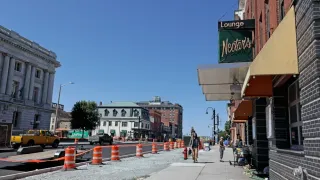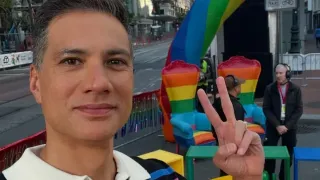November 16, 2014
Master of 20th-Century Hieroglyphics
Kilian Melloy READ TIME: 4 MIN.
That Keith Haring led a brief but fully engaged life is borne out big-time by "Keith Haring: The Political Line," a sprawling career retrospective of the openly gay artist that lifted off at the de Young last week.
An unabashed populist and ardent advocate for social justice in his life and art, Haring promoted safe sex and economic equality, while railing against AIDS and homophobia, racism in general and apartheid in particular, the excesses of capitalism and dangers of technology, the crack epidemic, and the perils of global warming. Haring believed that art was for everybody, and made good on that theory before he died from AIDS in 1990. He was 31.
A fraction of the voluminous body of work he left behind fills this new exhibition, which looks at his output from a political perspective. The art bursts with infectious vitality, much like the teeming brain of the man in overdrive who produced it. But, when assembled en masse, the sculptures and large-scale paintings on canvas and tarpaulin, whose surfaces are almost completely covered or tagged with drawn symbols, signs and imagery, can feel repetitive and busy, despite the museum's clean, meticulous installation.
Forged by the political turmoil of the 1960s and the fallout of the Vietnam War, and driven by a distrust of institutional power and an abhorrence of repression in all its insidious forms, Haring was inspired by graffiti and Pop Art, club music, hip-hop culture and Disney cartoons. He was at the center of New York's thriving downtown art-scene in the 1980s, where he rubbed shoulders with writers, musicians, and artists such as Roy Lichtenstein, Jean-Michel Basquiat, Kenny Scharf, Yoko Ono, Grace Jones, Madonna and Warhol, who became a friend and role model. In an homage, Haring combined the older artist's likeness with Mickey Mouse in his "Andy Mouse" paintings; envision repeated portraits of a bespectacled Warhol in mouseketeer ears and you get the idea.
When he arrived in New York City at 20, Haring was blown away by the public street art he encountered, a movement he embraced and for which he became an ersatz godfather. Although he hit the art world like a lightening bolt in the 1980s and his success was meteoric, he first made his mark (literally) as a graffiti artist in the city's subway system, appropriating empty black advertising panels that lined station walls. Using white chalk, he dashed off thousands of brash drawings, deploying the jazzy style and visual vocabulary that would populate his works for the ensuing decade: Infants emitting beams of light, spaceships zapping earthlings, barking dogs, pulsing TV sets, multi-limbed creatures of unknown origin, gorgons, and more erect phalluses than you can hang a hat on.
His subway drawings, which represent his work at its purest, line a corridor of a gallery. (What survived, in many cases, was stolen from stations.) Akin to 20th-century hieroglyphics that beg to be deciphered, their simplicity and mysterious origins piqued the curiosity of ordinarily oblivious New York City commuters. The politically-themed, overtly sexual imagery also attracted the media, a lucky turn of events that catapulted Haring to stardom, while enabling him to circumvent the art establishment. A color photograph capturing a paint-spattered, shirtless artist putting his imprint on a public space, with an audience of kids behind him, testifies to his "man of the people" appeal.
With his accessible forms, anti-elitist message and upbeat spontaneity - high on adrenaline, he started and finished a composition in a single marathon sitting - it's no wonder he's a hero to loners and young artists trying to break into the field. The show itself is a bid for that sought-after younger audience, which includes the underground constituencies who turn out for Mission School artist Barry McGee, an obvious Haring inheritor. Like McGee, Haring adapted his improvisational ethos to more traditional forms and made the jump to gallery and museum venues without losing his street cred. The museum is betting, perhaps justifiably, that it has a certifiable hit on its hands.
There's delight to be found in small-scale, cartoonish, Day-Glo neon pieces from the early 1980s, and a pair of eye-popping masks with fearsome protruding features and tribal markings ("Hollywood African Mask," "Burning Skull") that possess the menace and magnetism of their primitive African forebears - but Haring clearly gravitated toward the gigantic. That appetite is exemplified by "The Great White Way" (1988), a 14-foot-tall, pink phallus painted with a profusion of orgiastic imagery, crucifixes, piglets and weapons of war and torture. (He evidently disdained leaving even an inch of space blank.) An indictment of the violent repression of other cultures by Caucasians and organized religion, this was Haring's preferred tool for sticking it to the colonial oppressors.
A similar inclination is expressed in a large yellow, orange-and-black tarpaulin piece ("Untitled," 1983) featuring fascists with crocodile or dog masks and zippered mouths stomping and crushing the sea of humanity beneath their feet. In sections with cheery titles like Ecocide and Apocalypse, one can't miss "Untitled" (1985), a visceral Sodom-and-Gomorrah nightmare with a maze of black and blood-red pathways that lead nowhere. This purgatory or outright hell worthy of Hieronymus Bosch is inhabited by mythical beasts, devils and demons and a bevy of snakes slithering out of a headless torso with an erect penis.
On the local front, Haring loved San Francisco, where he visited many times and left an artistic legacy. He created a 1985 mural for the South of Market Childcare Center (St. Patrick's Daycare Center) and another at Club DV-8, which are now in private hands, as well as "The Life of Christ" (1990), a moving triptych sculpture installed in the AIDS chapel at Grace Cathedral. "Untitled (Three Dancing Figures)" (1989), a colorful outdoor sculpture whose playfulness and child-like optimism is especially poignant given it was created a year before his death, is displayed in front of the museum's main entrance, while its permanent location, Moscone Center, undergoes renovation.
A sidewalk tribute honoring Haring's contributions to the LBGT community is part of the Rainbow Honor Walk in the Castro.
Through Feb. 16, 2015






